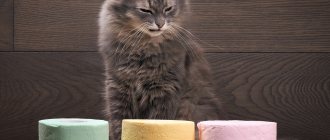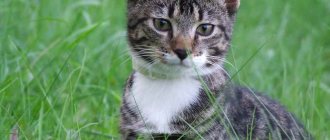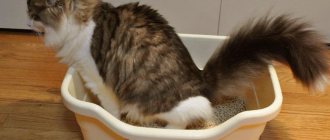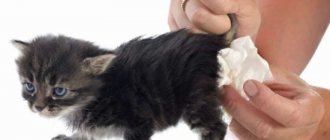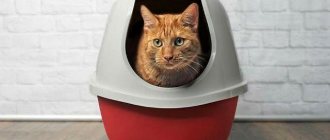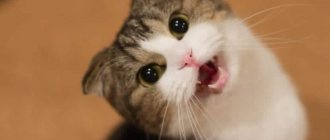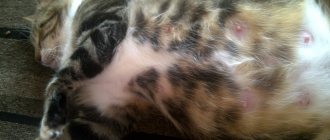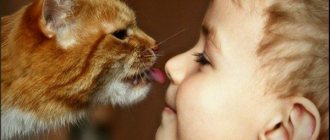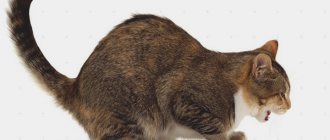Cat owners often have to deal with various health problems with their pets. The lion's share of diseases occurs in the gastrointestinal tract; representatives of the cat family especially often suffer from digestive disorders such as diarrhea or diarrhea. In most cases, bowel dysfunction does not pose a threat to the pet’s life and does not require drug therapy. However, in some cases, frequent loose stools may signal the development of a serious illness. Especially if there is blood in the stool, the animal’s condition deteriorates sharply, an upset stomach is accompanied by vomiting, the temperature rises, etc. In this case, it is important to know what to do and how to properly treat diarrhea in cats.
What is diarrhea in cats
Diarrhea (diarrhea) is not an independent disease; the condition is a signal of the presence of certain health problems in the cat. We are talking about dysfunction of the digestive tract, which is accompanied by excessive loss of fluid, pain in the abdomen, nausea, vomiting, weakness and loss of appetite. In cats, frequent loose stools are caused by increased intestinal motility, provoked by irritation of the intestinal mucosa by pathogenic bacteria or toxins.
Along with frequent defecation, the animal behaves restlessly, experiences discomfort, and often cannot find a place for itself. Despite the fact that in the vast majority of cases, a disorder of the digestive system does not pose a threat to the cat’s life, it is important to understand that prolonged diarrhea can lead to dehydration and can cause the death of the pet. It is extremely important to correctly recognize the symptoms of the disorder and promptly help the animal on your own at home or in a hospital.
Special dry food
In case of stool upset, the animal is temporarily transferred to dietary wet food in the form of pate, jelly, stew, and canned food. Dry granules damage inflamed mucous membranes of the gastrointestinal tract; in the first days it is better to soften them in cold water. Veterinary lines combine dry and semi-liquid food in cans and pouches. The composition includes easy-to-digest components.
The following foods are suitable for the diet:
- Hill's Prescription Diet I/D is prescribed for gastrointestinal diseases that are accompanied by diarrhea. The product is available in 2 versions: chicken and salmon based. The minimum duration of the diet is 1 week.
- Royal Canin Gastro Intestinal moderate calorie combines highly digestible LIP proteins, rice, prebiotics, beet pulp, fish oil. Use from 3 weeks.
- Purina EN is created on the basis of dry soy and poultry protein, corn starch, and animal fat. The cat is fed for 1–2 weeks until recovery.
- Eukanuba Intestinal is made from freeze-dried chicken and turkey meat and contains a complex for restoring microflora: natural beet fiber, prebiotics. The food is used for 7–14 days to stop diarrhea, and up to 12 weeks to restore digestion.
- Farmina Vet Life Cat Gastrointestinal is recommended to be given as prescribed by a veterinarian from 7 days to 3 months. The product is made from dehydrated chicken meat and rice. The composition contains components to restore intestinal function after diarrhea: soluble fiber, omega-3, psyllium seeds, prebiotics, vitamin complex and electrolytes.
Manufacturers recommend following the daily diet:
| Name | Cat weight, kg | Daily value, g |
| Royal Canin | 2 | 34 |
| 3 | 46 | |
| 4 | 56 | |
| 5 | 66 | |
| 6 | 75 | |
| 7 | 83 | |
| 8 | 92 | |
| 9 | 100 | |
| 10 | 107 | |
| Hills | 2 | 30–40 |
| 3 | 40–55 | |
| 4 | 50–70 | |
| 5 | 60–85 | |
| 6 | 70–95 | |
| 7+ | 11–13 per kg | |
| Purina Pro Plan | 2–3 | 30–45 |
| 3–4 | 45–60 | |
| 4–5 | 60–75 | |
| 5+ | 15 per kg | |
| Eukanuba | 2 | 30–40 |
| 3 | 40–60 | |
| 4 | 55–80 | |
| 5 | 70–100 | |
| 6 | 85–115 | |
| 8 | 110–155 | |
| 10 | 140–195 | |
| Farmina | 2 | 25–40 |
| 2,5 | 28–45 | |
| 3 | 32–50 | |
| 3,5 | 35–55 | |
| 4 | 38–65 | |
| 4,5 | 40–70 | |
| 5 | 45–75 | |
| 6 | 50–85 |
The daily diet is divided into equal portions and the pet is fed 3-4 times a day.
Symptoms of diarrhea
The symptoms of diarrhea are pronounced, the condition involves a frequent urge to empty the intestines, while the volume of a single bowel movement is less than usual, and the consistency is liquid. In addition, among the most common symptoms it is worth noting:
- acts of defecation – more than 3 times per day;
- watery, unformed stools;
- fecal incontinence, urgent urge to defecate;
- the color of the feces is light with shades of yellow, green, red if there is diarrhea with blood, and even black if the animal has damage to internal organs.
In addition, vomiting, painful spasms, lethargy, apathy and loss of appetite and other symptoms are often added to the existing picture. It is extremely important to recognize the symptoms in time and identify the root causes of the painful condition in order to understand what to do and what kind of help the cat needs.
Treatment
In the standard treatment regimen for diarrhea, the first step is a fasting diet for 24 hours. With a nursing cat, this option is not possible if the decision to wean the kittens from the mother has not been made. To reduce irritation of the intestinal walls and “fix” the feces, the cat is given rice water . It is really undesirable to feed a cat, therefore, in order to avoid dehydration and loss of milk, maintenance (nutrient) droppers are prescribed for the entire period of the starvation diet.
Trichopolum (metronidazole) is used as broad-spectrum drugs. When self-medicating, you need to be sure that the cat does not suffer from liver failure . If blood is released with feces, self-medication and delay are extremely dangerous, any help will be useless if the cat has a perforated intestine.
Usually, immediately after drips, the cat becomes visually better, but it is not worth stopping treatment and total control. Diarrhea can be considered cured if the cat has had normal bowel movements for more than 75 hours. If the period is prolonged or the illness recurs after a short time, diarrhea is only a symptom.
Causes
The most common cause of problems with the digestive tract is a change in the cat's usual diet. If frequent bowel movements occurred during the introduction of changes in diet, we can say with confidence that the cause of the disease lies precisely in this. In this case, indigestion can be cured without special therapy. All you need to do is return to your usual food. However, the causes of digestive disorders in cats are not limited only to errors in nutrition; a number of household factors can provoke a painful condition:
- unbalanced diet - the presence in the pet’s diet of raw fish, dairy products, fatty foods, which can cause digestive problems;
- too large portions or frequent feeding;
- transition from natural food to special food or vice versa;
- low-quality water, a change in its usual composition can affect the functioning of the gastrointestinal tract;
- food poisoning: a pet may suffer from consuming spoiled food that has expired;
- individual intolerance to any product, allergies;
- dysfunction of the digestive tract can be caused by medications; manufacturers of veterinary drugs often list diarrhea in the list of side effects;
- postoperative period;
- postpartum rehabilitation and the period of gestation are also often accompanied by gastrointestinal disorders.
Frequent urges to defecate may be caused by an unstable emotional state of the cat. An experienced stressful situation, unfavorable home conditions, excitement, fear, the appearance of other pets in the house, long-term separation from the owner, the arrival of guests, or moving can cause diarrhea. These factors should not be a cause for concern; usually, special treatment is not required, the pet recovers on its own immediately after the disappearance of the traumatic factor.
At the same time, the cause of diarrhea with blood in a pet (or without bloody discharge) may lie in the presence of life-threatening diseases:
- salmonellosis, E. coli infection and other bacterial infections;
- diarrhea and vomiting in a cat with white foam can be caused by viral diseases, including the so-called feline leukemia, rotavirus, panleukopenia, etc.;
- the causes of green diarrhea in a pet can be a consequence of various liver diseases, including pancreatitis;
- diarrhea in cats is caused by pathologies of the digestive system of various etiologies, including partial or complete intestinal obstruction;
- intoxication of the body that developed as a result of complex drug therapy or caused by severe poisoning;
- metabolic disorders, including diabetes;
- parasitic lesions of the body - roundworms, helminthic infestations, worms;
- oncology;
- pathologies of the urinary system;
- fungal infections (mycoses).
Separately, it is worth noting the causes of vomiting with white foam with frequent acts of defecation; their nature is most often physiological, thus the pet independently gets rid of undigested food and toxins. In the absence of accompanying symptoms that aggravate the animal’s health, special treatment is not necessary.
General information
So, diarrhea is the process of emergency removal of semi-digested food and already feces into the external environment. Everyone knows about this. But why can this happen to a cat that has barely given birth to kittens? There are a lot of possible reasons. But first, let's look at the main predisposing factors.
What do you think every cat loves? The answer is almost obvious - everyone thinks that these animals cannot live without fish and fresh milk. And this opinion, suddenly, is completely untrue. Fish, in particular, contains thiaminase. This is an enzyme that destroys vitamin B1. Frequent feeding of raw fish leads to nervous attacks... but not to diarrhea.
This is exactly what is fraught with giving milk to an adult cat. Especially cow's. The lactose it contains is practically not digested in the animal’s gastrointestinal tract. But on many thematic forums there is “valuable” advice that a cat that has given birth supposedly definitely needs milk! Yes, there is some truth in this. Your pet's body needs a lot of calcium during this period, and there is really a lot of it in milk.
But it would be much wiser to give your pet multivitamin preparations, after consulting with a veterinarian. What will happen to the cat after milk? Since it is not properly digested in its gastrointestinal tract (in about 70% of adult cats), fermentation processes quickly begin, the semi-digested mass curdles and becomes a “delicacy” for bacteria. The natural result is diarrhea. Especially after childbirth, when the animal’s body is already greatly weakened by stress.
Types of diarrhea in cats
Depending on the causes of the eating disorder, stool takes on different colors, textures and smells. Based on the analysis of these parameters, it is possible to draw a conclusion about the presence of a particular disease and determine a course of treatment at home.
Classification of diarrhea according to consistency and the presence of foreign impurities in the stool:
- liquid diarrhea, the presence of vomiting most likely indicates food poisoning;
- the presence of mucus in stool indicates damage to the large intestine;
- blood in the stool indicates the infectious nature of diarrhea, the presence of parasites, or indicates damage to internal organs.
Depending on the color of the stool, the following types of diarrhea are distinguished:
- yellow stool – incomplete digestion of food eaten;
- black color - indicates the presence of internal bleeding (you should seek emergency veterinary help or call a veterinarian at home), may also be a consequence of taking medications containing iron or indicate an excessive meat diet;
- green color - with a high degree of probability indicates the consumption of spoiled foods that provoke rotting processes in the intestines; you can treat green diarrhea yourself;
- white color - indicates the presence of problems in the biliary tract;
- orange color - the pet is experiencing severe intoxication and needs emergency help.
